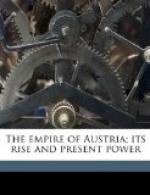On the 15th of June, 1665, Sigismond Francis, Duke of Tyrol, and cousin of Leopold, died, leaving no issue, and the province escheated with its million of inhabitants to Leopold, as the next heir. This brought a large accession of revenue and of military force, to the kingdom. Austria was now the leading power in Europe, and Leopold, in rank and position, the most illustrious sovereign. Louis XIV. had recently married Maria Theresa, eldest daughter of Philip IV., King of Spain. Philip, who was anxious to retain the crown of Spain in his own family, extorted from Maria Theresa, and from her husband, Louis XIV., the renunciation of all right of succession, in favor of his second daughter, Margaret, whom he betrothed to Leopold. Philip died in September, 1665, leaving these two daughters, one of whom was married to the King of France, and leaving also an infant son, who succeeded to the throne under the regency of his mother, Ann, daughter of Ferdinand III., of Austria. Margaret was then too young to be married, but in a year from this time, in September, 1666, her nuptials were celebrated with great splendor at Madrid. The ambitious French monarch, taking advantage of the minority of the King of Spain, and of the feeble regency, and in defiance of the solemn renunciation made at his marriage, resolved to annex the Spanish provinces of the Low Countries to France, and invaded the kingdom, leading himself an army of thirty thousand men. The Spanish court immediately appealed to Leopold for assistance. But Leopold was so embarrassed by troubles in Hungary, and by discontents in the empire that he could render no efficient aid. England, however, and other powers of Europe, jealous of the




